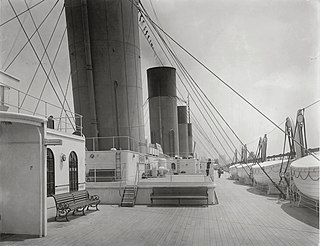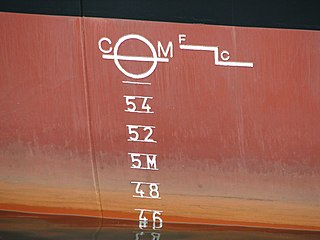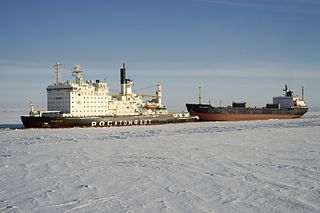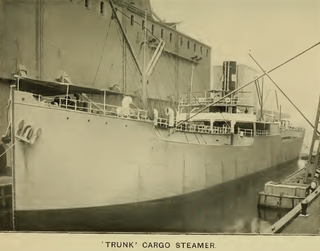Related Research Articles

A hull is the watertight body of a ship, boat, submarine, or flying boat. The hull may open at the top, or it may be fully or partially covered with a deck. Atop the deck may be a deckhouse and other superstructures, such as a funnel, derrick, or mast. The line where the hull meets the water surface is called the waterline.

An icebreaker is a special-purpose ship or boat designed to move and navigate through ice-covered waters, and provide safe waterways for other boats and ships. Although the term usually refers to ice-breaking ships, it may also refer to smaller vessels, such as the icebreaking boats that were once used on the canals of the United Kingdom.

Carvel built or carvel planking is a method of boat building in which hull planks are laid edge to edge and fastened to a robust frame, thereby forming a smooth surface. Traditionally the planks are neither attached to, nor slotted into, each other, having only a caulking sealant between the planks to keep water out. Modern carvel builders may attach the planks to each other with glues and fixings. It is a "frame first" method of hull construction, where the shape is determined by the framework onto which the planks are fixed. This is in contrast to "plank first" or "shell first" methods, where the outer skin of the hull is made and then reinforced by the insertion of timbers that are fitted to that shape. The most common modern "plank first" method is clinker construction; in the classical period "plank first" involved joining the edges of planks with mortise and tenon joints within the thickness of the timbers, superficially giving the smooth-hull appearance of carvel construction, but achieved by entirely different means.

Boat building is the design and construction of boats — and their on-board systems. This includes at minimum the construction of a hull, with any necessary propulsion, mechanical, navigation, safety and other service systems as the craft requires.

A cargo ship or freighter is a merchant ship that carries cargo, goods, and materials from one port to another. Thousands of cargo carriers ply the world's seas and oceans each year, handling the bulk of international trade. Cargo ships are usually specially designed for the task, often being equipped with cranes and other mechanisms to load and unload, and come in all sizes. Today, they are almost always built of welded steel, and with some exceptions generally have a life expectancy of 25 to 30 years before being scrapped.

A deck is a permanent covering over a compartment or a hull of a ship. On a boat or ship, the primary or upper deck is the horizontal structure that forms the "roof" of the hull, strengthening it and serving as the primary working surface. Vessels often have more than one level both within the hull and in the superstructure above the primary deck, similar to the floors of a multi-storey building, that are also referred to as decks, as are certain compartments and decks built over specific areas of the superstructure. Decks for some purposes have specific names.

Lloyd's Register Group Limited, trading as Lloyd's Register (LR), is a technical and professional services organisation and a maritime classification society, wholly owned by the Lloyd’s Register Foundation, a UK charity dedicated to research and education in science and engineering. The organisation dates to 1760. Its stated aims are to enhance the safety of life, property, and the environment, by helping its clients to improve the safety and performance of complex projects, supply chains and critical infrastructure.

A turret deck ship is a type of merchant ship with an unusual hull, designed and built in the late 19th and early 20th centuries. The hulls of turret deck vessels were rounded and stepped inward above their waterlines. This gave some advantages in strength and allowed them to pay lower canal tolls under tonnage measurement rules then in effect. The type ceased to be built after those rules changed. The last turret deck ship in existence was scrapped in 1960.

A bulk carrier or bulker is a merchant ship specially designed to transport unpackaged bulk cargo—such as grain, coal, ore, steel coils, and cement—in its cargo holds. Since the first specialized bulk carrier was built in 1852, economic forces have led to increased size and sophistication of these ships. Today's bulk carriers are specially designed to maximize capacity, safety, efficiency, and durability.

The waterline is the line where the hull of a ship meets the surface of the water.

A vessel's length at the waterline is the length of a ship or boat at the level where it sits in the water. The LWL will be shorter than the length of the boat overall as most boats have bows and stern protrusions that make the LOA greater than the LWL. As a ship becomes more loaded, it will sit lower in the water and its ambient waterline length may change; but the registered L.W.L is measured from a default load condition.

Ice class refers to a notation assigned by a classification society or a national authority to denote the additional level of strengthening as well as other arrangements that enable a ship to navigate through sea ice. Some ice classes also have requirements for the ice-going performance of the vessel.

Ship stability is an area of naval architecture and ship design that deals with how a ship behaves at sea, both in still water and in waves, whether intact or damaged. Stability calculations focus on centers of gravity, centers of buoyancy, the metacenters of vessels, and on how these interact.

Taymyr is a shallow-draft nuclear-powered icebreaker, and the first of two similar vessels. She was built in 1989 for the Soviet Union in Finland, at the Helsinki Shipyard by Wärtsilä Marine, by order of the Murmansk Shipping Company. Her sister ship is Vaygach.

The load line, also known as Plimsoll line, indicates the legal limit to which a ship may be loaded for specific water types and temperatures in order to safely maintain buoyancy, particularly with regard to the hazard of waves that may arise. The load line is a waterline that corresponds to the maximum draft of the ship, thus yet another name, load waterline. Varying water temperatures will affect a ship's draft, because warm water is less dense than cold water, providing less buoyancy. In the same way, fresh water is less dense than salinated or seawater, with a similar lessening effect upon buoyancy. The rules for international load lines are defined by the International Convention on Load Lines from 1966. For inland water transport regional, national or local rules apply.

Vaygach is a shallow-draught nuclear-powered icebreaker. She was built in 1989 for the Soviet Union by Wärtsilä Marine Helsinki Shipyard in Finland by order of the Murmansk Shipping Company and its KL-40 reactor was installed at the Baltic Shipyard in St. Petersburg. Her sister ship is Taymyr.

A trunk deck ship is a type of merchant ship with a hull that was stepped inward in order to obtain more favourable treatment under canal toll rules then in effect. As those tolls were set by net tonnage, a measure of volume, and as the tonnage rules did not account for all of the cargo space of such vessels, trunk deck ships incurred lower tolls than more conventional ships of equivalent capacity. When the measurement rules were changed, this ship type was no longer built.
Ship measurements consist of a multitude of terms and definitions specifically related to ships and measuring or defining their characteristics.

Finnish-Swedish ice class is an ice class assigned to a vessel operating in first-year ice in the Baltic Sea and calling at Finnish or Swedish ports. Ships are divided into six ice classes based on requirements for hull structural design, engine output and performance in ice according to the regulations issued by the Finnish Transport and Communications Agency (Traficom) and the Swedish Maritime Administration.
MV Stellar Daisy was a South Korean-owned very large ore carrier (VLOC) that sank on March 31, 2017 in the South Atlantic off the coast of Uruguay while on a voyage from Brazil to China. She was the largest ship, by a factor of nearly 2 on gross tonnage, to be lost at sea.
References
- 1 2 3 4 Chisholm, Hugh, ed. (1911). . Encyclopædia Britannica . Vol. 24 (11th ed.). Cambridge University Press. pp. 298–299.
- ↑ Keegan, John (1989). The Price of Admiralty . New York: Viking. p. 280. ISBN 0-670-81416-4.
- ↑ "Scantling Length (L)". Rules for Building and Classing Steel Vessels — Part 3: Hull Construction and Equipment (PDF). American Bureau of Shipping. 2007. Ch. 1, sec. 1, para. 3.1 (p. 3).